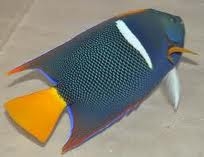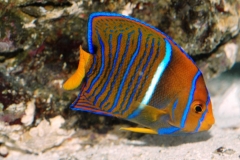Search the Community
Showing results for tags 'Holacanthus passer'.
-
Scientific Name Holacanthus passer Reef Compatible No Care Level Intermediate Disposition Semi-aggressive Min. Tank Size 100 gallons Mature Size 14 inches Diet Omnivore Range Central America The Passer Angelfish is also called the King Angelfish. The adult is predominately dark blue with a white vertical stripe extending down from the dorsal fin about two-thirds of the way to the pelvic fin. The dorsal fin is rimmed in yellow. The caudal and pectoral fins are also yellow, while the ventral fins are yellow on a female, and white on the male. The juvenile is orange with one white and multiple blue stripes. The Passer Angelfish can grow to over a foot in length so it requires at least a 220 gallon aquarium. It is a hardy fish, but can become aggressive, so it should be kept with other semi-aggressive tank mates. It grazes on live rock and will nip at stony and soft corals (sessile invertebrates) and clam mantles, so it is not a good candidate for a reef aquarium. The diet of the Passer Angelfish should include vegetable matter such as Spirulina, marine algae, meaty items, and high-quality angelfish preparations which include sponges. Feed at least three times daily. The Small Juvenile will contain the Juvenile colorations, the Small-Medium will be color shifting to a young adult, while the Medium will be a sub-adult, and the Large will be in Adult coloration.
-
- Holacanthus passer
- king angel
-
(and 1 more)
Tagged with:
-
Scientific Name Holacanthus passer Reef Compatible No Care Level Intermediate Disposition Semi-aggressive Min. Tank Size 100 gallons Mature Size 14 inches Diet Omnivore Range Central America The Passer Angelfish is also called the King Angelfish. The adult is predominately dark blue with a white vertical stripe extending down from the dorsal fin about two-thirds of the way to the pelvic fin. The dorsal fin is rimmed in yellow. The caudal and pectoral fins are also yellow, while the ventral fins are yellow on a female, and white on the male. The juvenile is orange with one white and multiple blue stripes. The Passer Angelfish can grow to over a foot in length so it requires at least a 220 gallon aquarium. It is a hardy fish, but can become aggressive, so it should be kept with other semi-aggressive tank mates. It grazes on live rock and will nip at stony and soft corals (sessile invertebrates) and clam mantles, so it is not a good candidate for a reef aquarium. The diet of the Passer Angelfish should include vegetable matter such as Spirulina, marine algae, meaty items, and high-quality angelfish preparations which include sponges. Feed at least three times daily. The Small Juvenile will contain the Juvenile colorations, the Small-Medium will be color shifting to a young adult, while the Medium will be a sub-adult, and the Large will be in Adult coloration.
-
- Holacanthus passer
- king angel
-
(and 1 more)
Tagged with:



